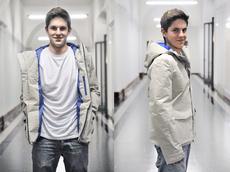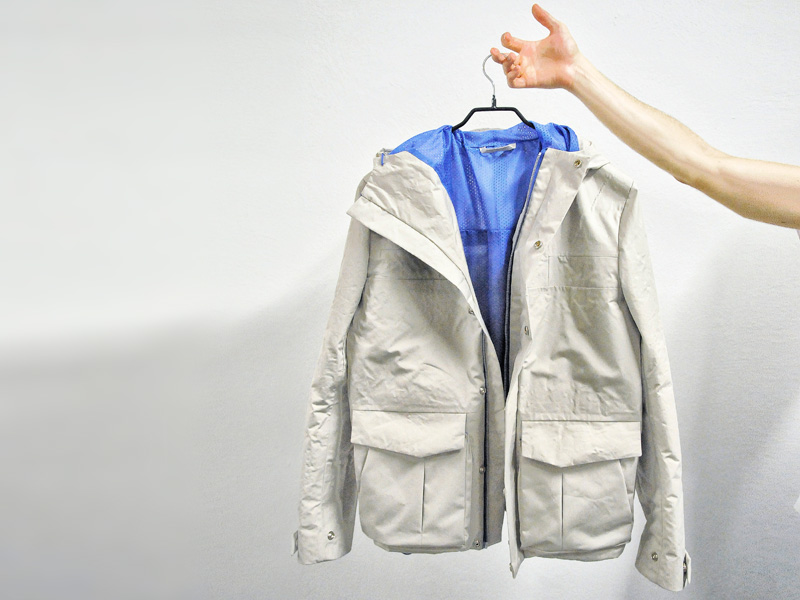The fluorine-free outdoor jacket
Water-resistant, breathable clothing often contains problematic fluorine compounds. As part of his master’s project, a student at ETH Zurich has developed a fluorine-free membrane that can very much hold its own against standard commercial products.

Chemical and bio-engineering student Mario Stucki managed to develop a jacket made from a new water-resistant material in just 16 weeks. He carried out his master’s project at Professor Wendelin Stark’s laboratory for functional material engineering; the group also carries out research on nanoporous materials. These materials are interspersed with holes at the nanoscale and may be used as highly sensitive filters. Nanoporous materials are often the first choice in the biotech sector or in the treatment of water for the retention of even the smallest particles.
However, it is far less widely known that even breathable water-resistant textiles such as Gore-Tex consist of a porous membrane. The way this works is quite simple: drops of water are about 200,000 times bigger than the membrane pores and therefore cannot penetrate. In contrast, body moisture in the form of a far less dense water vapour can easily pass through the membrane. Christoph Kellenberger, supervising PhD student for Stucki’s master’s project, explains: “All breathable sports textiles function on the basis of this principle. We therefore came up with the idea that our materials could also be used for textiles.”
Tricky Teflon
Gore-Tex and many other sports textiles have a crucial disadvantage: the membrane is made up of polytetrafluorethylene or PTFE, better known by its trade name of Teflon. In itself, Teflon is harmless as long as the fluorine that it contains is bonded. Released fluorine, however, is highly reactive, meaning that fluorine compounds can cause problems for many reasons. First, persistent toxic substances may develop even during the production process. If PTFE is burnt on disposal, toxic fluorine compounds may also escape and harm the environment. “The aim of my master’s project was therefore to develop a nanoporous material that has the same characteristics as the standard commercial membranes, but at the same time is fluorine-free so that it can be easily disposed of,” says Stucki, summarising his project.
The master’s student was able to benefit from the research group’s experience as it had already worked with various porous polymers. The process is very simple: researchers apply a mixture of a solvent, a polymer – in this case fluorine-free – and limescale nanoparticles on to a surface and leave the solvent to vaporize. What remains is a layer of plastic peppered with limescale particles. The researchers then dissolve the limescale with acid and tiny holes remain where the particles were. The plastic used by Stucki is authorised by the US Food and Drug Administration, meaning that it may also be used for prostheses or in the food industry.
Denser than standard commercial products
Laboratory tests quickly showed that the membrane held its own compared with standard commercial products. To measure the water-resistance of textiles, the unit of water columns is normally used whereby a water column of 1m corresponds to the hydrostatic pressure in a water depth of 1m. “Our material has a water column measurement of 60m. This means that it is more water-resistant than standard commercial products, which withstand only a maximum water column of 40m,” says Stucki. Breathability is usually specified in grams of water vapour per square metre, per day. The ETH membrane has a value of about 1000g of water vapour per square metre, per day. This value is in the same range as that of the tested products already on the market.
Jacket with a unique design
However, it wasn’t enough for the master’s student to develop and test a new membrane. He also wanted to find out whether the material would prove itself when put to a practical test. Kellenberger and Stucki found a textile company that manufactures material from water-resistant organic cotton – Stotz Fabrics in Zurich. Normally used for outdoor wear, the textiles are impregnated with poly- and perfluoroalkylated substances, a process that can also cause problems (see ETH Life). The textiles manufactured by Stotz Fabrics are treated with non-toxic paraffin. Stucki glued together the material and membrane using a standard commercial fluorine-free adhesive. He was also able to attract a designer with this project: Angela Wyss of Honschi (www.honschi.ch) designed and made a prototype fluorine-free jacket. The jacket was produced using standard methods, but the polymer proved to be quite stiff, making the jacket rather uncomfortable to wear. “However, it would be no problem to apply our technique to softer polymers to make the finished material more flexible,” explained Kellenberger.
The jacket is only a first attempt. It is currently not yet certain whether Kellenberger and Stucki will continue the project. They still have a long way to go in order to produce a marketable jacket, as the membrane not only plays an important role in comfort, but also in other elements such as workmanship and tailoring. Stucki has nonetheless shown that outdoor clothing of the future can be completely fluorine-free. And what’s more, it took only 16 weeks to prove it.








READER COMMENTS